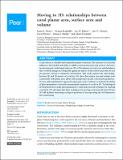Files in this item
Moving to 3D : relationships between coral planar area, surface area and volume
Item metadata
| dc.contributor.author | House, Jenny E. | |
| dc.contributor.author | Brambilla, Viviana | |
| dc.contributor.author | Bidaut, Luc M. | |
| dc.contributor.author | Christie, Alec P. | |
| dc.contributor.author | Pizarro, Oscar | |
| dc.contributor.author | Madin, Joshua S. | |
| dc.contributor.author | Dornelas, Maria | |
| dc.date.accessioned | 2018-02-28T12:30:06Z | |
| dc.date.available | 2018-02-28T12:30:06Z | |
| dc.date.issued | 2018-02-06 | |
| dc.identifier | 252416836 | |
| dc.identifier | a2a3fc9f-31a3-417d-94ca-5a8e4d842032 | |
| dc.identifier | 29435392 | |
| dc.identifier | 85041844967 | |
| dc.identifier | 000424497600001 | |
| dc.identifier.citation | House , J E , Brambilla , V , Bidaut , L M , Christie , A P , Pizarro , O , Madin , J S & Dornelas , M 2018 , ' Moving to 3D : relationships between coral planar area, surface area and volume ' , PeerJ , vol. 6 , e4280 . https://doi.org/10.7717/peerj.4280 | en |
| dc.identifier.issn | 2167-8359 | |
| dc.identifier.other | RIS: urn:4C8124A785091A8E8F7AD190C2D61DDD | |
| dc.identifier.uri | https://hdl.handle.net/10023/12819 | |
| dc.description | This work was supported by the School of Biology, University of St Andrews, the Scottish Funding Council (MASTS grant reference HR09011) and the Templeton Foundation (grant #60501, 'Putting the Extended Evolutionary Synthesis to the Test'). | en |
| dc.description.abstract | Coral reefs are a valuable and vulnerable marine ecosystem. The structure of coral reefs influences their health and ability to fulfill ecosystem functions and services. However, monitoring reef corals largely relies on 1D or 2D estimates of coral cover and abundance that overlook change in ecologically significant aspects of the reefs because they do not incorporate vertical or volumetric information. This study explores the relationship between 2D and 3D metrics of coral size. We show that surface area and volume scale consistently with planar area, albeit with morphotype specific conversion parameters. We use a photogrammetric approach using open-source software to estimate the ability of photogrammetry to provide measurement estimates of corals in 3D. Technological developments have made photogrammetry a valid and practical technique for studying coral reefs. We anticipate that these techniques for moving coral research from 2D into 3D will facilitate answering ecological questions by incorporating the 3rd dimension into monitoring. | |
| dc.format.extent | 19 | |
| dc.format.extent | 991826 | |
| dc.language.iso | eng | |
| dc.relation.ispartof | PeerJ | en |
| dc.subject | Coral reef | en |
| dc.subject | Scleractinia | en |
| dc.subject | Morphology | en |
| dc.subject | Scaling | en |
| dc.subject | Growth form | en |
| dc.subject | QH301 Biology | en |
| dc.subject | DAS | en |
| dc.subject | SDG 14 - Life Below Water | en |
| dc.subject.lcc | QH301 | en |
| dc.title | Moving to 3D : relationships between coral planar area, surface area and volume | en |
| dc.type | Journal article | en |
| dc.contributor.sponsor | John Templeton Foundation | en |
| dc.contributor.institution | University of St Andrews. School of Biology | en |
| dc.contributor.institution | University of St Andrews. Fish Behaviour and Biodiversity Research Group | en |
| dc.contributor.institution | University of St Andrews. Marine Alliance for Science & Technology Scotland | en |
| dc.contributor.institution | University of St Andrews. Centre for Biological Diversity | en |
| dc.identifier.doi | https://doi.org/10.7717/peerj.4280 | |
| dc.description.status | Peer reviewed | en |
| dc.identifier.grantnumber | 60501 | en |
This item appears in the following Collection(s)
Items in the St Andrews Research Repository are protected by copyright, with all rights reserved, unless otherwise indicated.

